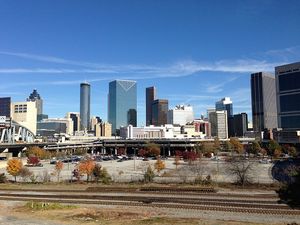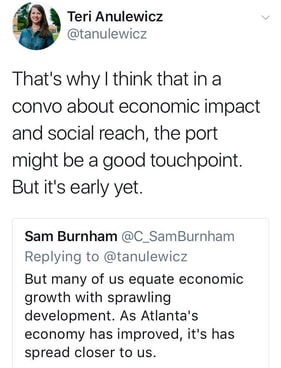|
By Sam Burnham @C_SamBurnham There is a lot of buzz being generated right now over the possibility of Amazon opening a secondary headquarters campus (HQ2) in the Atlanta area. There have been several rumored sites for the theoretical Atlanta location. There area several other cities in contention and each has its own strengths and weaknesses based on a list of Amazon's preferences in regard to infrastructure and quality of life. Many Georgians living outside the metro are casting a skeptical eye on this development and not because we think Atlanta can't pull this off. On the contrary, it's because we know Atlanta is the best choice on the list. When you look into the quality of life -museums, concerts, entertainment, sports, restaurants, bars, Atlanta is a magnet. Georgia's business friendly laws and regulations are specifically geared for this campaign. The presence of the Georgia Institute of Technology and the portion of Kennesaw State formerly Southern Polytechnic offers an Amazon River of entry level employees just minutes, perhaps only blocks, from the proposed locations. Atlanta's airport puts the employees of the new site within two hours of 75% of the US population and most major US business centers. This leaves only Atlanta's traffic and relatively meager transit system as a drawback for Amazon, who includes ease of commute and transportation in their list of preferences. With the City of Atlanta and Governor Deal both scrambling to do whatever it takes to get this deal done, the upcoming push for improved and expanded transit is all too predictable. Who Stands to Benefit "The Gulch" in Atlanta is One Possible Site For Amazon HQ2 "The Gulch" in Atlanta is One Possible Site For Amazon HQ2 As with all economic development in the Peach State, Atlanta stands to reap major benefits from this deal. While Cobb, Dekalb, and other metro counties could actually be the host of the site, the amenities of Atlanta are the draw and will be raking in the cash spent by an estimated 50,000 employees averaging $100,000 annually. If we do see the expanded transit it will take to seal this deal outright, Cobb, Dekalb, (wealthy northern) Fulton, Gwinnett, and perhaps Hall counties on the north end will see new transportation options to better connect them with the new jobs and the amenities we've mentioned. There would be similar benefits for Douglas, (growing) southern Fulton, Clayton, and Henry counties. These counties are where the incoming Amazons will live, work, and play. The annual influx of $5 billion in salaries alone would be a economic boom for the state. There is no denying the actual numbers of the deal. Add in the operational costs (theoretically spent locally) for maintaining such a campus would fund vendors and other businesses in the area well beyond the foreseeable future. This is a very big deal. The Unseen CostsGeorgia Changed forever on September 18, 1990. An announcement in Tokyo, Japan proclaimed Atlanta as the host of the 1996 Summer Olympic Games. Atlanta was a growing city and showed much economic promise. But the Olympics changed the game forever. In the years leading up to the games, Atlanta grew rapidly. The city was on the map. The whole world was talking about it. Businesses and people came in droves. They loved the climate, the economy, and everything else Atlanta was coming to offer. They stayed. And more came behind them. In 27 years Atlanta has gone from a big city by the standards of the South to a world class metropolis. It has been an amazing transformation to say the least. But what people living in the non-metro areas have learned in that time is that there is no wall around that metropolis to keep it in. While many other world class cities have grown up and up towards the clouds, Atlanta has grown up and out, spreading across the landscape like a patch of concrete kudzu, covering everything in its path. This is where the perceptions of the people of outlying Georgia come into play. This is where understanding the concerns of "fly-over" or even "drive-past" Georgia will make a difference if there must be a state-wide push to make this deal happen. Everyday, Atlantans sit in traffic possibly thinking that they are beginning or finishing a day of productive economic activity that benefits the economy of the state. What they don't know is that there are a multitude of people in the TV market area that are watching the traffic updates on channels 2, 5, 11, and 46 and laughing at the "fools" sitting in traffic. It is like the zoo where people observe captive species and wonder at their mannerisms and behavior. But mostly they just hope to never live in such a manner. Pile on the crime, lack of affordable housing, the small building lots, and lack of exposed earth, count us out. We don't want that. Not in our back yard. But that is what we see every single time the strip malls, overhead superhighways, and office parks pop up just a little closer to the house. And there is no Roundup for that sort of kudzu. There is no way to resist it as farm after forest falls under the bulldozer, never to be seen again. Ironically, the people in the bulldozers and those who follow, immediately begin to lecture us on the environment, climate change, emissions, recycling, "sustainability." It becomes the Once-ler giving the Lorax a good lesson on conservation. This is what folks outside Metro Atlanta hear when Atlantans tell us about the economic benefits of this deal. When Atlanta booms, it lands on us. And we don't necessarily want it. Reaching for Cooperation Metro Democrat & Rural Conservative Having Rational Discussion About Georgia Economic Development Metro Democrat & Rural Conservative Having Rational Discussion About Georgia Economic Development I don't want to finish this article without covering a Twitter conversation I had on Thursday with Teri Anulewicz on this very topic. Teri is a Democratic candidate for Georgia House District 42 as well as the former Smyrna Ward 3 representative and Mayor Pro Tem. She was reaching out to me in search of understanding after I had tweeted about my diminished enthusiasm for the Amazon HQ2 Atlanta plan. This was a honest search for understanding and the genuineness of the conversation was refreshing in these times. The transit improvements will require some regional, if not state-wide, cooperation. Atlanta cannot do this alone. But selling the plan to the outlying areas is going to be difficult. There would be some greater access to transit for many Georgians. But will the cost be worth the amount of times we plan to use the improvements? As long as we see Atlanta transit (again, perception) as a place to pay to get mugged on an inconvenient time schedule, we're going to drive our own cars and pay to park. If the parking disappears, we just won't go. It won't be worth it. If you want to sell transit improvements to us, show us how it makes our lives better directly or we will never agree to help pay for it. That is where the conversations like the one Teri and I had this past week become vital in our future. Metro folks need to listen to our concerns, understand that we don't always see their idea of economic growth as beneficial to us. We often see it as counterproductive and dangerous to our communities and our way of life. It also won't hurt us to listen as well. Perhaps in doing so we develop a better relationship between the "two Georgias" and can find benefits for both sides in the discussion. For example, in our discussion Teri and I agreed that the expansion of the Port of Savannah benefited the whole state. Projects like that can be cooperative and everyone can win a little. Both of our ideas of good economics are represented. If we can create new ways for Atlanta to thrive without paving the entire state, that can be a similar situation. I don't think we have to have it one way or the other. Honestly, I think Atlanta is too far gone for us to ever have it "our" way. I don't think our economy or environment can withstand having it only "their" way. So now we are faced with the reality of the metro and the rural partnering for a healthy coexistence. But that requires respect, trust, communication, and some willingness that I saw Thursday. And thank you, Teri, for being a part of that. Let us look to the future: trust but verify.
0 Comments
By Sam Burnham
@C_SamBurnham Hurricane Irma came and went. It wasn't much more here than a couple dozen gusts of wind and a good soaking rain. The worst of the storm came and died on the ridge lines we have folded up around us. But the last two or three days have been particularly sad to see the photos from family and friends across the other parts of the state and down in Florida. We've seen places we love that are swamped with floodwaters, covered by fallen trees, some damaged beyond repair. This is the reality for so many people affected by this storm. Even friends in the metro area are still without power after three or four days. We've seen Ft. Pulaski, which is featured on our home page, flooded by the flooding and storm surge at the mouth of the Savannah River. We've seen the Ogeechee, featured in the header above, spilling over its banks into Fish Tales (a favorite restaurant of ours.) We've seen that same river flooding Ft. McAllister State Park. The cabin where I wrote several blog posts covering our last Coastal Georgia road trip can be seen upon stilts above the mingling of the river and the marsh. That's just a few of the sites we've visited. That doesn't cover the loss of private property or even human life that Irma caused. As the floodwaters recede, we start to see the resilience of the people. The staff at Ft. Pulaski and Ft. McAllister are already in the repair and recovery mode. The dining area at Fish Tales was cleaned out, put back in order, and had the laborers responsible for the efforts enjoying cold beverages by last evening. These places serve as a metaphor for the overall recovery. Seeing "Birdmane" from Grassroots Farms sneaking back in on washed out dirt back roads to survey his farm for damage was a high point for me yesterday. People are jumping back in. I mentioned in the previous post that I'm afraid for South Georgia. With crop and livestock losses as well as damage to homes and already sketchy infrastructure, I worry many folks will give up. I hope they don't. I hope they prove to be every bit as tough as I think they are. By Sam Burnham
@C_SamBurnham As I'm watching the first of the outer bands of Irma begin to arrive here, my thoughts are still lying well to the south. Friends and family in the Sunshine State and those who live below Georgia's Gnat Line are still in harm's way or in the very early stages of recovery from what has been a nasty storm. But there are divides here that I want to discuss as they will be pivotal points in the upcoming recovery. There are two faces of the Florida peninsula. Along the coasts and through the I-4 corridor is the Florida most people know. Beaches, resorts, Disney, Universal, golf courses, urban areas. Then there is the rest of the interior. Orange groves, cattle and horse farms, small towns, fish camps, good grits eating country folks. In Georgia, there is Metro Atlanta, the north Georgia area and then there is the plain south of the Gnat Line. Florida is flat. The highest point in Florida is Britton Hill. At 345 feet, it's half the distance above sea level as my flat front yard. The highest point on the peninsula is Sugarloaf Mountain. This peak sits at 312 feet, give or take, depending on if there is a fire ant mound active at the top or not. In Georgia, the Gnat Line, that prehistoric coast line that divides the present day Piedmont from the Coastal Plain, crosses the state from (roughly) Columbus to Macon to Augusta, Geologists and boat captains know it as the Fall Line. These flat areas give little resistance to the wind but take the brunt of the storm as it weakens over the dry ground. That means that the storm is weaker by the time the geographic features of north Georgia shield us from most of the wind and turn the tempest into a trickle. But these areas also suffer the heaviest damage. They are often the areas that have the fewest resources with which to recover as well. Overwhelmed public safety departments in hundreds of small Southern towns are currently doing their best to protect and serve with what they have to work with. In the Southeast, as in Texas, the big cities are going to suffer but they'll also recover. My major concern is with the smaller towns - some already dying - that are now looking at a long road to recovery. A road I fear many will decide isn't worth traveling. These are the quaint villages you see here or at Vanishing South Georgia and several other sites that also care about the loss of historical and cultural significance when rural towns die. This is a rambling post, I know. It is as much for me as it is for anyone else. It's a way for me to put into words and visually inspect my thoughts and concerns. It's a chance to brainstorm for ways to help. It's a chance to hold up places like Brunswick, Waycross, or Tifton when I know Atlanta is going to take a shot, need help, and get it. It is me begging all of us to not forget Williston, Ft. McCoy, or Interlachen Florida in the shadow of Tampa's recovery. Our big cities will need help. And they will get it. And I'm not arguing they shouldn't. Let's just please not forget the small places, the ones that feed and clothe us, while we help the bright lights recover. Keep South Georgia and interior Florida in your prayers |
Sam B.Historian, self-proclaimed gentleman, agrarian-at-heart, & curator extraordinaire Social MediaCategories
All
Archives
November 2022
|




 RSS Feed
RSS Feed
